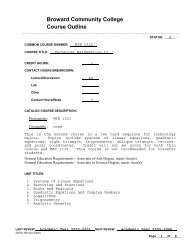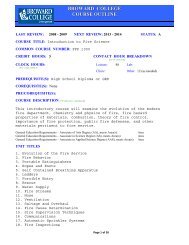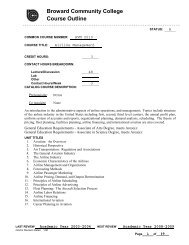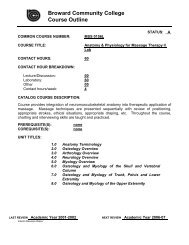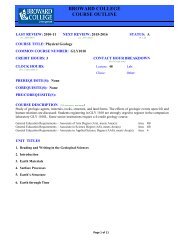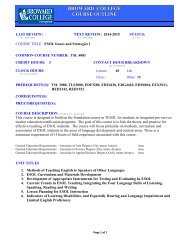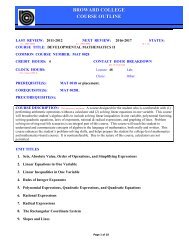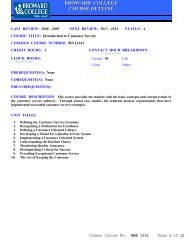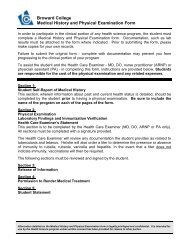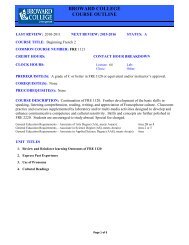ARH2050 - Broward College
ARH2050 - Broward College
ARH2050 - Broward College
Create successful ePaper yourself
Turn your PDF publications into a flip-book with our unique Google optimized e-Paper software.
BROWARD COLLEGE<br />
COURSE OUTLINE<br />
LAST REVIEW: 2010-2011 NEXT REVIEW: 2015-2016 STATUS: A<br />
(i.e. 2006-2007) (i.e. 2011-2012) (A, I, D)<br />
COURSE TITLE: Art History: Prehistory to Gothic<br />
COMMON COURSE NUMBER: <strong>ARH2050</strong><br />
CREDIT HOURS: 3 CONTACT HOUR BREAKDOWN<br />
(Per 16 week term)<br />
CLOCK HOURS: Lecture: 48 Lab:<br />
(Voc. Course ONLY)<br />
Clinic: Other:<br />
PREREQUISITE(S): None<br />
COREQUISITE(S): None<br />
PRE/COREQUISITE(S): None<br />
COURSE DESCRIPTION: Art History: Prehistory to Gothic is a chronological survey and analysis<br />
of art from prehistory to approximately 1400, placing major works in a historical and stylistic<br />
context and emphasizing world art.<br />
General Education Requirements – Associate of Arts Degree (AA), meets Area(s): Area 2<br />
General Education Requirements – Associate in Science Degree (AS), meets Area(s): Area 2<br />
General Education Requirements – Associate in Applied Science Degree (AAS), meets Area(s): Area 2<br />
UNIT TITLES<br />
1. Prehistoric Art<br />
2. Ancient Art: Near East, Egypt, Greece, Rome<br />
3. Asian Art: India, China, Japan<br />
4. Early Christian and Byzantine Art<br />
5. Islamic Art<br />
6. Medieval and Gothic Art of Europe<br />
7. Indigenous Arts of the Americas<br />
8. African Art<br />
9. Museum Assignment<br />
Page 1 of 13
BROWARD COLLEGE<br />
COURSE OUTLINE<br />
*** Complete the following only if course is seeking general education status ***<br />
GENERAL EDUCATION Competencies and Skills *:<br />
In the box to the right of the Competency/Skill, enter all specific student learning outcome unit numbers, as indicated in the course outline<br />
(i.e. 1.1, 2.7, 4.2, 4.0 and 5.12) that apply.<br />
Course must include all of the following:<br />
1. Read with critical comprehension** 1.1-1.2, 2.1-2.4, 3.1-3.3, 4.1-4.2, 5.1-5.3, 6.1-6.5, 7.1-7.3,<br />
8.1-8.7<br />
2. Write clearly and coherently** 1.1-1.2, 2.1-2.4, 3.1-3.3, 4.1-4.2, 5.1-5.3, 6.1-6.5, 7.1-7.3,<br />
8.1-8.7, 9.1-9.5<br />
3d. Demonstrate literacy as appropriate within a given 1.1-1.2, 2.1-2.4, 3.1-3.3, 4.1-4.2, 5.1-5.3, 6.1-6.5, 7.1-7.3,<br />
discipline**<br />
8.1-8.7 (3d cultural literacy for all)<br />
4. Apply problem solving skills or methods to make 1.1-1.2, 2.1-2.4, 3.1-3.3, 4.1-4.2, 5.1-5.3, 6.1-6.5, 7.1-7.3,<br />
informed decisions in a variety of contexts**<br />
8.1-8.7<br />
Course must include at least one of the following:<br />
5. Differentiate between ethical and unethical behavior<br />
6. Demonstrate an understanding of the physical,<br />
biological, and social environments and how individual<br />
behaviors impact this complex system.<br />
7. Demonstrate an understanding of and appreciation for<br />
human diversities and commonalities<br />
8. Speak and listen effectively.<br />
1.1-1.2, 2.1-2.4, 3.1-3.3, 4.1-4.2, 5.1-5.3, 6.1-6.5, 7.1-7.3,<br />
8.1-8.7<br />
*General Education Competencies and Skills endorsed by 2010-2011 General Education Task Force<br />
**Required Competencies<br />
1) Read with critical comprehension.<br />
The student will be introduced to the basic texts, concepts, vocabulary, and methods necessary for developing<br />
an understanding of the discipline and meeting the required benchmarks as stated in the course outline.<br />
2) Write clearly and coherently.<br />
The student will demonstrate an understanding and mastery of subject matter in a variety of ways, including<br />
writing. Writing activities may include both graded and ungraded essays, short answer quizzes, summaries,<br />
reactions, journals, and various other reports.<br />
3) Demonstrate and apply literacy across all the disciplines (indicate which ones apply).<br />
a) Information literacy means understanding how to locate needed information, using the appropriate<br />
technology for the task, managing and evaluating the extracted information and using it effectively and<br />
ethically.<br />
b) Technology literacy is the ability to responsibly and effectively use appropriate technology to access,<br />
manage, integrate, or create information, and/or use technology to accomplish a given task.<br />
c) Workplace literacy is having the appropriate knowledge and skills to communicate and work with<br />
others effectively and perform job duties, whether it is through the use of computers and/or other<br />
technology.<br />
d) Cultural literacy is recognizing, understanding, and appreciating the similarities and differences<br />
between one’s own culture and the cultures of others through a study of the arts, customs, beliefs,<br />
values, and history that define a culture.<br />
e) Quantitative literacy is having the ability to formulate, solve and interpret mathematical/statistical<br />
operations and graphical/tabular representations to make informed decisions.<br />
f) Scientific literacy means understanding the methodology and application of the scientific process, the<br />
physical and biological worlds, and recognizing that scientific knowledge is continuously updated or<br />
revised as new information is discovered.<br />
Page 2 of 13
BROWARD COLLEGE<br />
COURSE OUTLINE<br />
4. Apply problem-solving skills or methods to make informed decisions in a variety of contexts.<br />
The student will use acquired skills or methods to recognize, analyze, adapt, and apply critical<br />
thinking to solve problems and make informed decisions.<br />
Page 3 of 13
EVALUATION:<br />
BROWARD COLLEGE<br />
COURSE OUTLINE<br />
In the box to the right of the Methods of Assessment, enter all specific learning outcome numbers (i.e. 1.1, 2.7, 4.0, 4.2 and 5.12) that apply.<br />
1. Portfolio<br />
2. Short essays 1.1-1.2, 2.1-2.4, 3.1-3.3, 4.1-4.2, 5.1-5.3, 6.1-6.5, 7.1-7.3,<br />
8.1-8.7<br />
3. Research Papers<br />
4. Group projects<br />
5. Discussions (In class, no online) 1.1-1.2, 2.1-2.4, 3.1-3.3, 4.1-4.2, 5.1-5.3, 6.1-6.5, 7.1-7.3,<br />
8.1-8.7<br />
6. Multiple Choice tests 1.1-1.2, 2.1-2.4, 3.1-3.3, 4.1-4.2, 5.1-5.3, 6.1-6.5, 7.1-7.3,<br />
8.1-8.7<br />
7. Presentations<br />
8. Service Learning Projects<br />
9. Pop quizzes<br />
10. Take-home tests 1.1-1.2, 2.1-2.4, 3.1-3.3, 4.1-4.2, 5.1-5.3, 6.1-6.5, 7.1-7.3,<br />
8.1-8.7<br />
11. Summaries and critiques<br />
12. Reaction papers 1.1-1.2, 2.1-2.4, 3.1-3.3, 4.1-4.2, 5.1-5.3, 6.1-6.5, 7.1-7.3,<br />
8.1-8.7<br />
13. Surveys<br />
14. Performance<br />
15. Short answer tests 1.1-1.2, 2.1-2.4, 3.1-3.3, 4.1-4.2, 5.1-5.3, 6.1-6.5, 7.1-7.3,<br />
8.1-8.7<br />
16. Classroom debates and colloquia<br />
17. Blogs, wikis, web pages<br />
18. Other (Please explain)<br />
a. Museum Writing Assignment a.9.1-9.5<br />
b. Short research assignments b. 1.1-1.2, 2.1-2.4, 3.1-3.3, 4.1-4.2, 5.1-5.3, 6.1-6.5, 7.1-7.3, 8.1-8.7<br />
Page 4 of 13
UNITS<br />
Unit 1 Prehistoric Art<br />
General Outcome:<br />
BROWARD COLLEGE<br />
COURSE OUTLINE<br />
Common Course Number: <strong>ARH2050</strong><br />
1.0 The student shall be able to identify and then interpret prehistoric art and be<br />
able to relate this art to cultural values and contexts in writing and tests.<br />
Specific Measurable Learning Outcomes:<br />
Upon successful completion of this unit, based on assigned readings, discussions, and<br />
lectures, the student shall be able to interpret, contrast, and compare canon works of art<br />
from prehistory including:<br />
1.1 Paleolithic art such as cave painting and sculpture<br />
1.2 Neolithic art such as art at Catal Hoyuk, Ain Ghazal, and Stonehenge<br />
Page 5 of 13
BROWARD COLLEGE<br />
COURSE OUTLINE<br />
Common Course Number: <strong>ARH2050</strong><br />
Unit 2 Ancient Art: Near East, Egypt, Greece, Rome<br />
General Outcome:<br />
2.0 The student shall be able to identify, and then interpret art in the ancient world<br />
and be able to relate this art to cultural values and contexts in writing and tests.<br />
Specific Measurable Learning Outcomes:<br />
Upon successful completion of this unit, based on assigned readings, discussions, and<br />
lectures, the student shall be able to interpret, contrast, and compare canon works of art and<br />
architecture from major ancient cultures including:<br />
2.1 The Near East: Sumer, Akkad, Babylon, Assyria, Neo-Babylon, and Persia<br />
2.2 Egypt including Early Dynastic, Old Kingdom, and New Kingdom periods<br />
2.3 Greece including Prehistoric Aegean, Archaic, Classical and Hellenistic periods<br />
2.4 Rome including Etruscan, Republican, and Imperial art<br />
Page 6 of 13
Unit 3 Asian Art: India, China, Japan<br />
General Outcome:<br />
BROWARD COLLEGE<br />
COURSE OUTLINE<br />
Common Course Number: <strong>ARH2050</strong><br />
3.0 The student shall be able to identify, and then interpret art in major Asian<br />
cultures before 1400 and be able to relate this art to cultural values and<br />
contexts in writing and tests.<br />
Specific Measurable Learning Outcomes:<br />
Upon successful completion of this unit, based on assigned readings, discussions, and<br />
lectures, the student shall be able to interpret, contrast, and compare canon works of art and<br />
architecture from Asian cultures including:<br />
3.1 India including art from Hindu and Buddhist traditions<br />
3.2 China including art from Shang, Qin, Han, Tang, Song, and Yuan Dynasties<br />
3.3 Japan including art from the Kofun, Asuka, Nara, Heian, Kamakura, and Muromachi periods<br />
Page 7 of 13
Unit 4 Early Christian and Byzantine Art<br />
General Outcome:<br />
BROWARD COLLEGE<br />
COURSE OUTLINE<br />
Common Course Number: <strong>ARH2050</strong><br />
4.0 The student shall be able to identify, and then interpret art from Early<br />
Christian and Byzantine cultures and be able to relate this art to cultural values<br />
and contexts in writing and tests.<br />
Specific Measurable Learning Outcomes:<br />
Upon successful completion of this unit, based on assigned readings, discussions, and<br />
lectures, the student shall be able to interpret, contrast, and compare canon works of art and<br />
architecture from Christian cultures including:<br />
4.1 Early Christian including funerary, architecture, mosaics, and manuscript illumination art<br />
4.2 Byzantine including sites such as Constantinople, Ravenna, Mount Sinai, Daphni, and Venice<br />
Page 8 of 13
Unit 5 Islamic Art<br />
General Outcome:<br />
BROWARD COLLEGE<br />
COURSE OUTLINE<br />
Common Course Number: <strong>ARH2050</strong><br />
5.0 The student shall be able to identify, and then interpret art from Islamic<br />
cultures before 1400 and be able to relate this art to cultural values and<br />
contexts in writing and tests.<br />
Specific Measurable Learning Outcomes:<br />
Upon successful completion of this unit, based on assigned readings, discussions, and<br />
lectures, the student shall be able to interpret, contrast, and compare canon works of art and<br />
architecture from Islamic art forms including:<br />
5.1 Architecture such as Dome of the Rock, mosques at Kairouan, Cordoba, and Isfahan, and the<br />
Alhambra palace at Granada.<br />
Iran.<br />
5.2 Luxury arts of calligraphy, glass works such as mosque lamps, and carpets such as those from<br />
5.3 Illuminations for secular or historical manuscripts.<br />
Page 9 of 13
Unit 6 Medieval and Gothic Art of Europe<br />
General Outcome:<br />
BROWARD COLLEGE<br />
COURSE OUTLINE<br />
Common Course Number: <strong>ARH2050</strong><br />
6.0 The student shall be able to identify, and then interpret art from the Middle<br />
Ages in Europe before 1400 and be able to relate this art to cultural values and<br />
contexts in writing and tests.<br />
Specific Measurable Learning Outcomes:<br />
Upon successful completion of this unit, based on assigned readings, discussions, and<br />
lectures, the student shall be able to interpret, contrast, and compare canon works of art and<br />
architecture from Early Medieval, Romanesque, and Gothic periods in Europe including:<br />
6.1 Early Medieval art such as that of the warrior lords, Hiberno-Saxon, Carolingian, and Ottonian<br />
6.2 Romanesque art including that from France, the Holy Roman Empire, Italy, Normandy, and<br />
England<br />
6.3 Gothic art including the development of the cathedral, stained glass and related sculpture in<br />
France, England, the Holy Roman Empire, and Italy<br />
6.4 Gothic book illumination in France<br />
6.5 Italian Gothic sculpture including artists such as Pisano, and painting including artists such as<br />
Cimabue, Giotto, Duccio, and Martini<br />
Page 10 of 13
Unit 7 Indigenous Arts of the Americas<br />
General Outcome:<br />
BROWARD COLLEGE<br />
COURSE OUTLINE<br />
Common Course Number: <strong>ARH2050</strong><br />
7.0 The student shall be able to identify, and then interpret art from the indigenous<br />
cultures of the Americas before 1400 and be able to relate this art to cultural<br />
values and contexts in writing and tests.<br />
Specific Measurable Learning Outcomes:<br />
Upon successful completion of this unit, based on assigned readings, discussions, and<br />
lectures, the student shall be able to interpret, contrast, and compare canon works of art and<br />
architecture from indigenous cultures of the Americas including:<br />
7.1 Mesoamerican including the Olmec, Teotihuacan, the Mayan, and the Toltec<br />
7.2 South America including Paracas, Nasca, and Moche<br />
7.3 North America including Mississippian, and Pueblo<br />
Page 11 of 13
Unit 8 African Art<br />
General Outcome:<br />
BROWARD COLLEGE<br />
COURSE OUTLINE<br />
Common Course Number: <strong>ARH2050</strong><br />
8.0 The student shall be able to identify, and then interpret art from early African<br />
cultures and be able to relate this art to cultural values and contexts in writing<br />
and tests.<br />
Specific Measurable Learning Outcomes:<br />
Upon successful completion of this unit, based on assigned readings, discussions, and<br />
lectures, the student shall be able to interpret, contrast, and compare canon works of art<br />
from early African cultures including such art as:<br />
8.1 Nok terracottas<br />
8.2 Igbo Ikwu bronzes<br />
8.3 Ille-Ife royal art<br />
8.4 The Great Mosque at Djenne<br />
8.5 The architecture of Great Zimbabwe<br />
8.6 Benin sculpture and architecture<br />
8.7 Sapi export sculptures<br />
Page 12 of 13
Unit 9 Museum Assignment<br />
General Outcome:<br />
BROWARD COLLEGE<br />
COURSE OUTLINE<br />
Common Course Number: <strong>ARH2050</strong><br />
9.0 The student shall be able to identify, describe, and then interpret world art in a<br />
museum setting through writing.<br />
Specific Measurable Learning Outcomes:<br />
Upon successful completion of this unit, based on observation of actual works in a<br />
museum setting, students shall describe, analyze, and interpret art in an essay based on<br />
criteria posed by their instructor including topics such as:<br />
9.1 Analyzing form based on formal elements such as line, color, shapes, volumes, value, texture,<br />
pattern, and space<br />
9.2 Analyzing form based on the principles of composition such as balance, rhythm, proportion,<br />
scale, emphasis, unity and variety<br />
9.3 Inferring subject matter by describing what is depicted in the work and/or by comparing the<br />
subject matter of different works<br />
9.4 Examining content (meaning) by relating the work to information in the assigned readings or<br />
lectures and/or by comparing and contrasting different works in the museum<br />
9.5 Inferring content by using form and/or subject matter as visual evidence to formulate meaning<br />
Page 13 of 13



